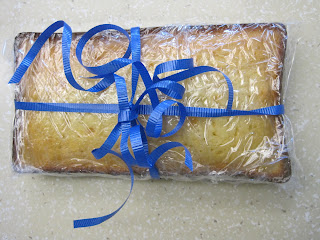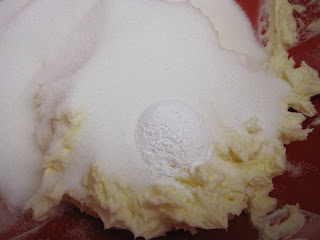

There are things I love about it. For example, everything in it is mine. Dutch Oven: mine. Le Creuset utensil holder: mine. Blue Emile Henry pie dish that is currently holding napkins on top of the frig: mine. The window is also wonderful. Note the basil and rosemary on the window sill.
Then there are things that I am going to have to get used to. For example, there are no markings on my stove-top nobs. There is 'Hi/Lite'; other than that, I am on my own for medium-high heat.

Also, the oven nob is well worn and completely inaccurate. Thank God for my oven thermometer. Even if you have a working nob, get a thermometer. Your nob may look all shiny and new, but it is probably lying to you.

For my first major undertaking in my new kitchen, I thought I would bake a 'thank-you' lemon pound cake for my parents. They helped me move and they were wonderful.

While it may look all pretty wrapped with a bow, there was nothing pretty about making this cake.
Everything started out just fine. I brought my ingredients up to room temperature. Maybe everyone else in the world knows you are supposed to do this, but I only got in this habit last year. I knew it helped ingredients combine, but it wasn't until I was reading my King Arthur Baker's Companion over breakfast (and yes, this is something I actually do), that I learned why. It's all about the butter. You know how you whip butter, often with sugar at the beginning of a cake or cookie recipe? This is because you want to incorporate air into the butter. This air contributes to the light and fluffy quality of the batter and will the cake or cookie rise. You want the eggs and other ingredients to be at the same temperature, to help the butter retain its air. If you add cold eggs to that lovely, fluffy butter, the eggs will actually cause the butter to release the air you just whipped in. Also, it turns out you often whip butter with sugar because the sugar also helps the butter retain air. And I learned all of this over a bowl of cereal.

With my butter and cream cheese at room temperature, it was time to start the cake by whipping them together. Look at how fluffy it was.


Then I zested my organic lemons. If you are using the zest, it is really important to buy organic. 'No pesticides in your cake' seems like a general rule to live by.


Then I added salt,

sugar,
 baking powder,
baking powder,
vanilla,

lemon zest,

and flour.
 I mixed that for 5 minutes. And, yes, I timed it.
I mixed that for 5 minutes. And, yes, I timed it.


I thought everything was going just fine until this Liz Lemon 'what the what' moment:


Yes, that's right: that is lemon zest stuck on my beaters. In fact, it appears the lemon zest did not actually make it into the cake batter because it was too busy glomming to the metal. So, instead of scooping batter off the beaters to put into my mouth, I had to scoop lemon zest off the beater, to incorporate into the batter. I didn't want to overmix, so I folded it back in. Okay, I was back on track. And I figured that the lemon zest would get distributed as I beat the eggs in.
Now, it was time to add the eggs, one at a time. I always crack an egg into a separate bowl before putting it in the batter. For this recipe, you add the eggs one by one, scraping down the sides and bottom after each addition.




After I put the last egg in, I checked the beaters for lemon zest. And, yes, it had somehow magically attracted itself to the beaters yet, again. So I manually pulled it off the beaters. Again. Look at all of it.

After (angrily) stirring that zest in, the batter was ready to go into the pans.

I wanted to use two loaf pans. And only once I was ready to pour the batter in did I realize the recipe called for two 8 1/2 x 4 1/2 inch loaf pans, instead of 9 x 5 pans. Okay, I thought. No problem. I will just reduced the cook time by 5 minutes and everything will be fine.


False.
 (look, I was so miffed I couldn't even take a straight picture)
(look, I was so miffed I couldn't even take a straight picture)I pulled them out after 30 minutes and they were definitely over done. Not burnt, but, not exactly 'golden'. I hate overbaking cakes. To me, over-baking cake results in that dry-crumbly cake that you buy at bad coffee shops. I kept my fingers crossed that the glaze would help combat the dry-ness.

Not wanting to see my mistake, I decided to flip them over and glaze the side that didn't look dark brown.

This did not help anything.
But, I marched on. As I said, these cakes have a lemon-glaze, which is very easy to make. You heat lemon juice and sugar over low heat, until the sugar dissolves.



 (you can tell the sugar is dissolved when the mixture gets translucent like this)
(you can tell the sugar is dissolved when the mixture gets translucent like this)When it was time to drizzle the glaze, I aggressively poked holes all over the cake. I enjoyed this part, in no small part due to the frustration over the over-baking. And, I was at first worried about making too many holes, but then I realized, more holes equals more moisture in the cake. So, I threw caution to the wind and poked holes all over the 'top'.


I needed to figure out how to best divided the glaze in two. I decided to take a 1/4 cup measure with a spout and start glazing each cake with a 1/4 cup. Once that had soaked in, I simply divded what little remained of the glaze evenly over the two cakes.


 The glaze really does look lovely spilling over the sides.
The glaze really does look lovely spilling over the sides.
But then, the glaze decided to pool around the edges of the cakes. So, with my fingers, I redistributed the glaze over the non-pool-ish parts. A brush may have been a better way to go.

And then they were done.


I waited a few hours until the glaze had set in, and braced myself for the worst.

But, I should have braced myself for delicious. The cake turned out just fine. The lemon flavor from the wily zest and glaze was just right. The cream cheese was a marvelous addition. It lent the cake a bit of tang, creaminess, and moisture. And, believe it or not, the cake wasn't dry at all. Instead, it was moist, not-too dense, and a pleasure to eat.

My first undertaking was not exactly flawless, but I suppose this kitchen is one of 'learning'. Consider me schooled:
Lesson #1: make sure you have the pans called for in the recipe. If you don't, maybe do some research on baking directions for the pan size you do have. For these cakes, I think I could have poured all the batter into one 9x5 loaf pan and baked it for about 45 minutes. If I wanted to do the two loaf pans, I probably should have decreased the baking time more, or even reduced the temperature to 325. Then again, I could just buy the right size loaf pans.
Lesson #2: Beware the lemon zest. I still am baffled by what happened with the zest. Is it magnetic? Regardless, in the future, I will be careful to inspect my beaters for zest and make sure all that flavor gets into the cake and not washed away in the sink. Next time, I might try tossing the zest with the flour and hope that the flour coating prevents the zest from becoming one with the beater.
Lesson #3: If you make the bottom of the cake the top of the cake, glaze will pool around the edges. To avoid this, I will try brushing the glaze on. Alternatively, perhaps I should just not make make the bottom of the cake the top.
Lesson #4: Making the bottom of the cake the top doesn't actually undo the fact that you over-baked the cake.
Lesson #5: Sometimes when you over-bake a cake, it can still come out moist. Don't lose hope. And if it does come out dry: why not top it with a scoop of ice cream or a quick raspberry sauce. Come on now!
Lesson #6: Disasters sometimes end up in scrumptious lemon pound cake. So, as Julia Child says, "be fearless"!
Lemon-Glazed Pound Cake (from The King Arthur Flour Baker's Companion)
Ingredients:
14 tablespoons butter
1 package cream cheese
1/2 tsp salt
1 1/2 cups sugar
1 tsp baking powder
2 tsp vanilla extract
1 Tablespoon lemon zest
1 3/4 cups all purpose flour
5 eggs
For the glaze:
1/4 cup fresh lemon juice
1/2 cup sugar
Directions:
Preheat oven to 350 and grease two 8 1/2 x 4 1/2-inch loaf pans or a 9- to 10- cup bundt pan [I used two 9 x 5 inch loaf pans].
In a medium bowl, beat together the butter and cream cheese until soft and fluffy. Add the salt, sugar, baking powder, vanilla, lemon, and flour. Beat for 5 minutes; the batter will be stiff.
Add 1 egg, beating well until combined. Continue to add the eggs one at a time, beating well and scraping the sides and bottom of the bowl after each addition.
When done, the batter will be very fluffy. Spoon the batter into the prepared pan(s).
Bake the cake for 55-60 minutes (for the bundt pan) or 35-40 minutes (for the two loaf pans), or until a cake tester inserted into the center comes out clear. [I baked my larger loaf pans for 30 minutes and this caused the cake to be over-baked. Next time, if i used those pans again, I might check after 20 or 25 minutes].
For the glaze, just before the cake is done, combine the lemon juice and sugar and heat over low heat until the sugar has dissolved. Don't let the mixture boil.
Remove the cake from the oven and let it cool for 10 minutes in the pan. Turn it out onto a wire rack or serving plate. Poke the top all over with a cake tester or tooth pick and gradually drizzle the glaze over it, pausing occasionally to let it sink in. Let the cake cool for several hours before slicing.

No comments:
Post a Comment